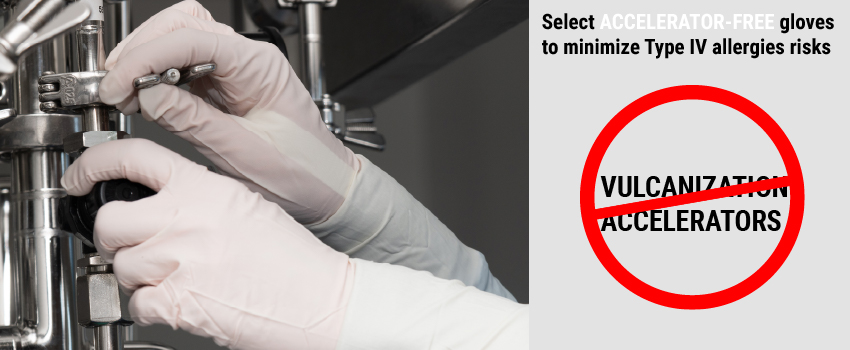ACCELERATOR-FREE GLOVES TO LIMIT THE RISK OF ALLERGY

To conclude our series on allergies resulting from wearing single-use gloves, let’s return to the subject of vulcanisation accelerators. Indeed, some disposable gloves are referred to as “accelerator-free”. Do you really know what vulcanisation accelerators are? Which are they and why are they used? What role do these vulcanisation accelerators play in triggering allergies? Are “accelerator-free” gloves really free of accelerators? A few explanations are in order.
VULCANISATION ACCELERATORS: WHAT ARE WE TALKING ABOUT?
WHAT ARE DISPOSABLE GLOVES MADE OF?
First of all, it should be remembered that single-use gloves are usually made of materials with “elastic” properties, called elastomers. These include natural rubber latex or nitrile (Acrylonitrile Butadiene). Natural rubber latex not only offers excellent elasticity properties, it also gives the gloves a high degree of dexterity. Nitrile is a synthetic rubber copolymer that also offers many advantages for manufactures of single-use gloves: flexibility and resistance to both physical and chemical products.
WHAT PROCESS IS USED TO MAKE SINGLE-USE GLOVES?
Whether natural rubber latex or nitrile is used, making single-use gloves involves vulcanising these elastomers, i.e. creating “bridges” between the molecular chains.
To achieve this, the vulcanisation process is used. This involves adding a chemical agent known as vulcanisation (very often sulphur) to the elastomer to obtain, after curing, a material that takes on its full elasticity capacities.
Forming “bridges” between the molecular chains can take a long time, which is why other agents are sometimes introduced during the disposable glove manufacture process to speed it up: these are – as the name suggests – “vulcanisation accelerators”.
The main accelerators used in the manufacture of single-use gloves are:
- Thiurames
- Dithiocarbamates
- Benzothiazoles
- Guanidines
- Thioureas
- Aldehydes amines
Of these accelerators, the most commonly used in the disposable glove industry are undoubtedly Thiurams and Dithiocarbamates. It should also be noted that curing (during vulcanisation) can lead to the formation of other compounds.
WHAT RISKS ARE ASSOCIATED WITH THE PRESENCE OF ACCELERATORS?
UNDERSTANDING THE TYPE IV ALLERGY TO SINGLE-USE GLOVES
In our previous article on Type IV allergies, also known as allergic contact dermatitis or delayed hypersensitivity reaction, we listed a number of products containing potential allergens that can cause these allergies. In particular, we mentioned cosmetics, disinfectants, certain metallic compounds (such as nickel), plants and numerous chemical agents (antioxidants, colouring agents, etc.). Above all, we must bear in mind that thousands of chemicals, some of which are used in our daily activities, are potentially allergenic.
However, in 80% of proven cases of Type IV allergy resulting from total use of disposable gloves, vulcanisation accelerators are the reason.
These chemical agents are therefore the allergens responsible for the typical symptoms of Type IV allergy linked to the wearing of disposable gloves, i.e., mainly skin damage (redness, swelling, etc.). These symptoms appear between 6 and 48 hours after contact and are not necessarily limited to the area directly in contact with the allergen (the hand in the case of allergens in the gloves used). Instead, they may spread across a wider area (to the arm, neck, etc.).
LIMITING THE RISK OF TYPE IV ALLERGIES WHEN WEARING GLOVES
The frequent and prolonged wearing of single-use gloves is an aggravating factor which explains why this type of allergy is very often found among medical and care professionals, as well as anyone whose profession involves them wearing single-use gloves.
First and foremost, the initial action to be taken in the event of a suspected Type IV allergy is to change gloves and then, if symptoms persist, to undertake a more thorough investigation of the causes with an occupational physician or dermatologist.
As the majority of Type IV allergies are caused by vulcanisation accelerators, it is highly advisable to find out what the gloves you are using are made of and the conditions under which they were manufactured in order to ensure that they are of good quality.
SELECTING “ACCELERATOR-FREE GLOVES”
In response to the growing need to limit the risk of Type IV allergies, many manufacturers of single-use latex and nitrile gloves are now producing “accelerator-free” gloves.
It is therefore recommended to use gloves described as “accelerator-free” and to be very careful when using misleading statements such as “hypoallergenic” or “suitable for allergy sufferers”. These statements refer to the absence of natural latex rubber (responsible for Type I allergies).
SHIELD Scientific has “accelerator-free” sterile and non-sterile gloves, for both laboratory and cleanroom use:
- SHIELDskin™ ORANGE NITRILE™ 260 Gloves
- SHIELDskin™ ORANGE NITRILE™ 300 Sterile Gloves
- SHIELDskin XTREME™ ORANGE NITRILE™ 300 DI Gloves
- SHIELDskin XTREME™ Sterile ORANGE NITRILE™ 300 DI Gloves
- SHIELDskin XTREME™ White Nitrile 300 DI++ Gloves
We can help you select SHIELD Scientific single-use gloves that limit the risk of allergic reactions while providing the protective properties you are looking for. We can do this by providing you with:
Technical data sheets for each SHIELD Scientific nitrile or natural rubber latex glove.
Our online glove selection guide.
Should you wish additional information, please feel free to contact us.
Share this interesting information
